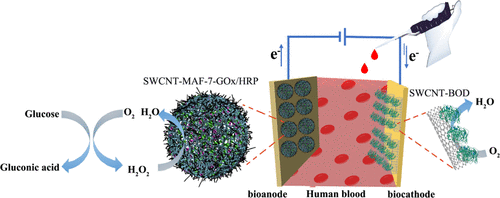当前位置:
X-MOL 学术
›
ACS Appl. Mater. Interfaces
›
论文详情
Our official English website, www.x-mol.net, welcomes your
feedback! (Note: you will need to create a separate account there.)
Efficient Blood-toleration Enzymatic Biofuel Cell via In Situ Protection of an Enzyme Catalyst.
ACS Applied Materials & Interfaces ( IF 8.3 ) Pub Date : 2020-08-19 , DOI: 10.1021/acsami.0c11186 Tajiguli Yimamumaimaiti 1 , Xuanzhao Lu 1 , Jian-Rong Zhang 1 , Linlin Wang 1 , Jun-Jie Zhu 1
ACS Applied Materials & Interfaces ( IF 8.3 ) Pub Date : 2020-08-19 , DOI: 10.1021/acsami.0c11186 Tajiguli Yimamumaimaiti 1 , Xuanzhao Lu 1 , Jian-Rong Zhang 1 , Linlin Wang 1 , Jun-Jie Zhu 1
Affiliation

|
The enzymatic biofuel cell (EBFC) has been considered as a promising implantable energy generator because it can extract energy from a living body without any harm to the host. However, an unprotected enzyme will be destabilized and even eventually be deactivated in human blood. Thus, the performance of implantable EBFC has received barely any improvement. It is therefore a breakthrough in realizing a superior efficient EBFC that can work stably in human blood which relies in protecting the enzyme to defend it from the attack of biological molecules in human blood. Herein, we innovatively created a single-walled carbon nanotube (SWCNT) and cascaded enzyme-glucose oxidase (GOx)/horseradish peroxidase (HRP) coembedded hydrophilic MAF-7 biocatalyst (SWCNT-MAF-7-GOx/HRP). The SWCNT-MAF-7-GOx/HRP is highly stable in electrocatalytic activity even when it is exposed to high temperature and some molecular inhibitors. In addition, we were pleasantly surprised to find that the electrocatalytic activity of GOx/HRP in hydrophilic SWCNT-MAF-7 far surpasses that of the GOx/HRP in hydrophobic SWCNT-ZIF-8. In human whole blood, the SWCNT-MAF-7-GOx/HRP catalytic EBFC exhibits an eightfold increase in power density (119 μW cm–2 vs 14 μW cm–2) and 13-fold increase in stability in comparison with the EBFC based on an unprotected enzyme. In this study, the application of metal–organic framework-based encapsulation techniques in the field of biofuel cells is successfully realized, breaking a new path for creating implantable bioelectrical-generating devices.
中文翻译:

通过酶催化剂的原位保护有效的血液耐受性酶生物燃料电池。
酶促生物燃料电池(EBFC)被认为是一种有前途的可植入能量产生器,因为它可以从生物体内提取能量,而不会对宿主造成任何伤害。但是,未保护的酶将在人血中不稳定,甚至最终失活。因此,植入式EBFC的性能几乎没有改善。因此,实现可在人血中稳定工作的卓越高效的EBFC是一项突破,它依赖于保护酶以保护其免受人血中生物分子的攻击。在这里,我们创新地创建了一种单壁碳纳米管(SWCNT)和级联的酶-葡萄糖氧化酶(GOx)/辣根过氧化物酶(HRP)共嵌入亲水性MAF-7生物催化剂(SWCNT-MAF-7-GOx / HRP)。即使暴露在高温和某些分子抑制剂的作用下,SWCNT-MAF-7-GOx / HRP的电催化活性也非常稳定。此外,我们惊奇地发现,GOx / HRP在亲水性SWCNT-MAF-7中的电催化活性远远超过GOSW / HRP在疏水性SWCNT-ZIF-8中的电催化活性。在人类全血中,SWCNT-MAF-7-GOx / HRP催化EBFC的功率密度增加了八倍(119μWcm–2 vs 14μWcm –2),与基于未保护酶的EBFC相比,稳定性提高了13倍。在这项研究中,成功实现了基于金属-有机框架的封装技术在生物燃料电池领域的应用,从而打破了创建可植入生物发电设备的新途径。
更新日期:2020-09-16
中文翻译:

通过酶催化剂的原位保护有效的血液耐受性酶生物燃料电池。
酶促生物燃料电池(EBFC)被认为是一种有前途的可植入能量产生器,因为它可以从生物体内提取能量,而不会对宿主造成任何伤害。但是,未保护的酶将在人血中不稳定,甚至最终失活。因此,植入式EBFC的性能几乎没有改善。因此,实现可在人血中稳定工作的卓越高效的EBFC是一项突破,它依赖于保护酶以保护其免受人血中生物分子的攻击。在这里,我们创新地创建了一种单壁碳纳米管(SWCNT)和级联的酶-葡萄糖氧化酶(GOx)/辣根过氧化物酶(HRP)共嵌入亲水性MAF-7生物催化剂(SWCNT-MAF-7-GOx / HRP)。即使暴露在高温和某些分子抑制剂的作用下,SWCNT-MAF-7-GOx / HRP的电催化活性也非常稳定。此外,我们惊奇地发现,GOx / HRP在亲水性SWCNT-MAF-7中的电催化活性远远超过GOSW / HRP在疏水性SWCNT-ZIF-8中的电催化活性。在人类全血中,SWCNT-MAF-7-GOx / HRP催化EBFC的功率密度增加了八倍(119μWcm–2 vs 14μWcm –2),与基于未保护酶的EBFC相比,稳定性提高了13倍。在这项研究中,成功实现了基于金属-有机框架的封装技术在生物燃料电池领域的应用,从而打破了创建可植入生物发电设备的新途径。











































 京公网安备 11010802027423号
京公网安备 11010802027423号